Janik Haberer is a midfielder who plays for SC Freiburg in the Bundesliga. He joined Freiburg from Hoffenheim in 2016 and has been an ever-present in the side since.
Haberer is tall at 6’2, and he has a lean build too. The 25-year-old is right-footed and is a particularly useful member of the Freiburg squad due to his ability to perform well in a number of different positions.
Haberer can play as a 6 or an 8 in the centre of midfield, as a winger on either side or even as a forward, as a 9 or a 10. However, as his heat map from this season shows, he is predominantly used on the right-side as central-midfielder or right-midfielder
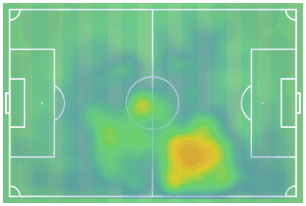
Although he hasn’t played at right-back, I think it is likely he could well perform at a good level in this position too. Including right-back this is seven positions that Haberer could fill in a team, potentially making him an attractive prospect for sides looking to bolster their squad this transfer window. Haberer has also yet to sign a new contract, with his current deal running out at the end of this season. This means he could leave on a free transfer this summer, which Freiburg will surely look to prevent from happening, or be available below his market value, which is £9million, according to transfermarkt.
This scout report and tactical analysis looks at what Haberer brings to the Freiburg side, how he fits into their tactics, and what could make him a potential transfer target for teams looking to gatecrash the European qualification spots in Europe’s top five leagues.
Dropping deep to receive
Haberer rarely looks to turn on the ball when receiving the ball in a central-midfield position. However, he frequently looks to show for possession as his defence seek to play out from the back.
He is far more comfortable playing with the ball in front of him, and when playing as a central-midfielder he is fond of dropping into the defence when Freiburg have possession, between the centre-backs or, most frequently, in the right-back position, to ensure he receives the ball in front of him.
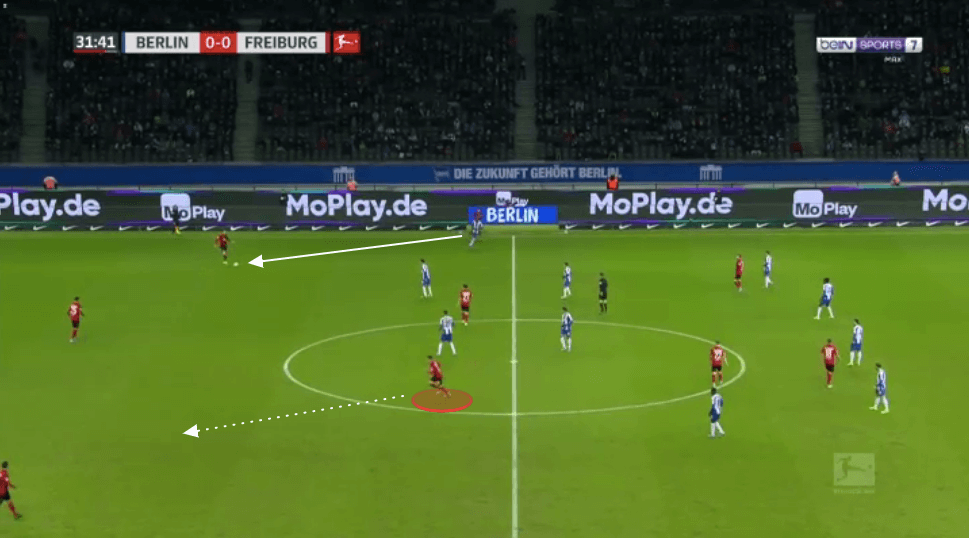
As he does this he has plenty of space to either dribble or pass into, particularly in the space he has vacated by dropping deep, as the analysis below shows.
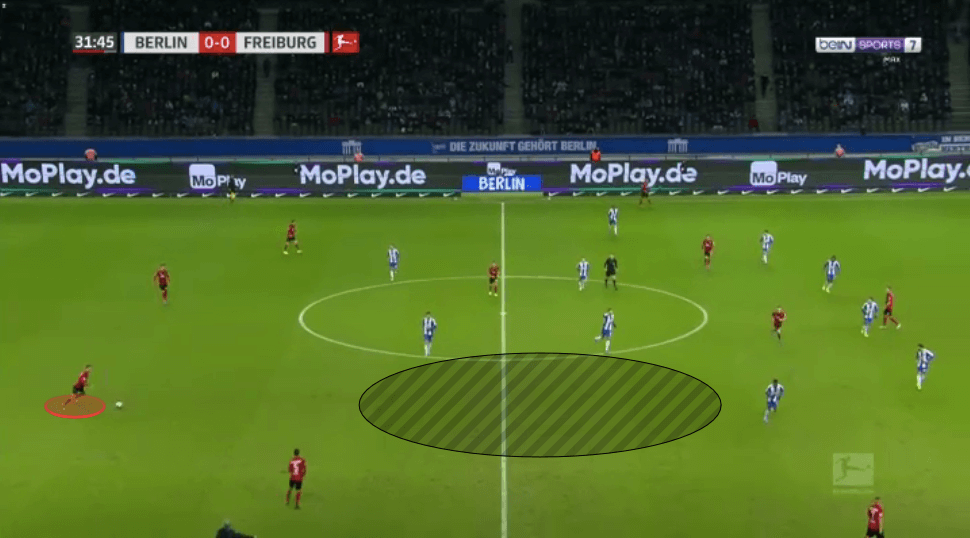
By dropping into the right-back area to receive, Haberer is able to elude his marker, whilst bring the opposition press forward. At the same time it gives right-back Jonathan Schmid the option to move higher, and find space on the right-wing.
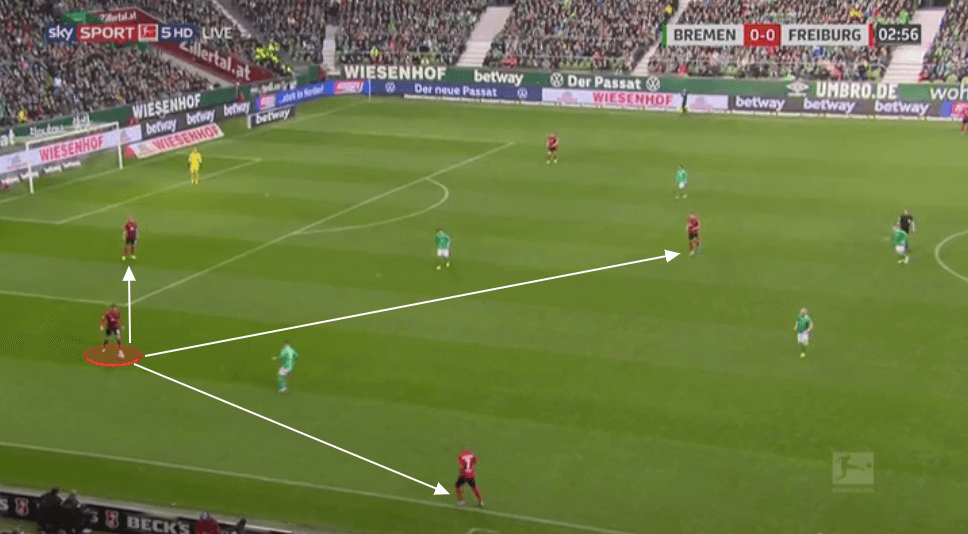
Haberer is a good passer, with an 86.2% completion percentage this season, and doesn’t let his distaste for turning on the ball in the middle of the pitch, deter him from using his passing range to begin attacks for Freiburg. By dropping deeper it allows him to get the ball with space and find easy forward-passing options.
How Haberer creates and manipulates space
Haberer predominantly plays as a centre-midfielder or right-midfielder. He affects the game in different ways from these positions, however, a constant throughout is his ability to create space for his teammates through his movement.
So much of Haberer’s game is about the manipulation of space, and manoeuvring the opponent’s defensive shape with his movement.
When Haberer doesn’t drop into the backline in Freiburg’s build-up play, he will nevertheless drop to give an option for the centre-backs. As mentioned above, Haberer rarely looks to turn on the ball, and will usually simply bounce the ball back to the defence. By making this run, he ensures he brings a marker with him and creates more space in the midfield. Haberer constantly vacates space to create passing lanes or just more space for his teammates to operate in.
This is no doubt a tactical ploy from Head Coach Christian Streich who favours the use of his centre-backs to launch attacks, particularly when using Robin Koch as a centre-back who is an excellent ball-player. Haberer drops in to receive the ball and creates space behind him for Freiburg to play through straight into their forward line.
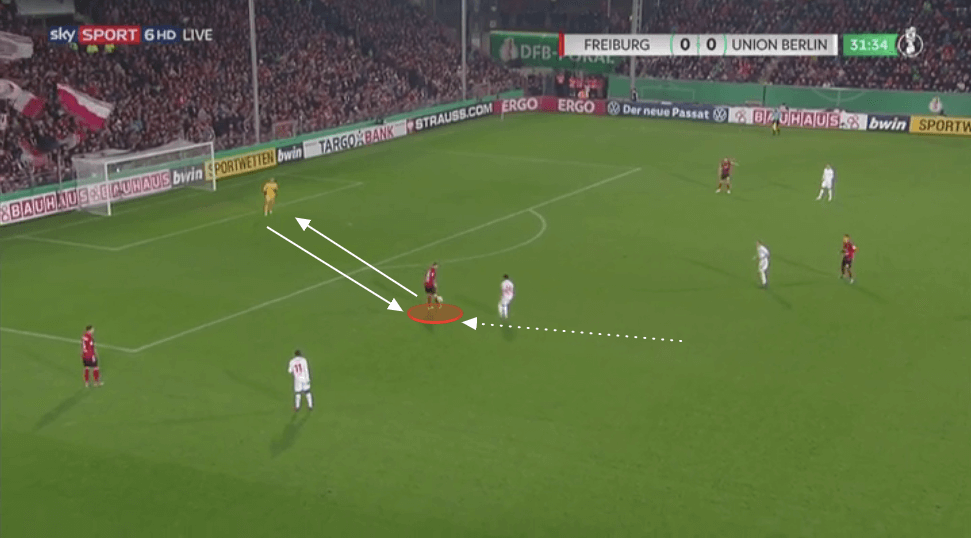
However, Haberer doesn’t just do this when playing in a deeper role. So much of his game is based around creating space with his movement for players to receive passes.
When playing as a central-midfielder, Haberer isn’t the sort of player to play piercing through balls. In fact, he averages just 0.54 through passes a game with just a 37.5% completion. Rather Haberer takes on more of a carrilero role, circling the ball, and playing the majority of his passes laterally, if not backwards.
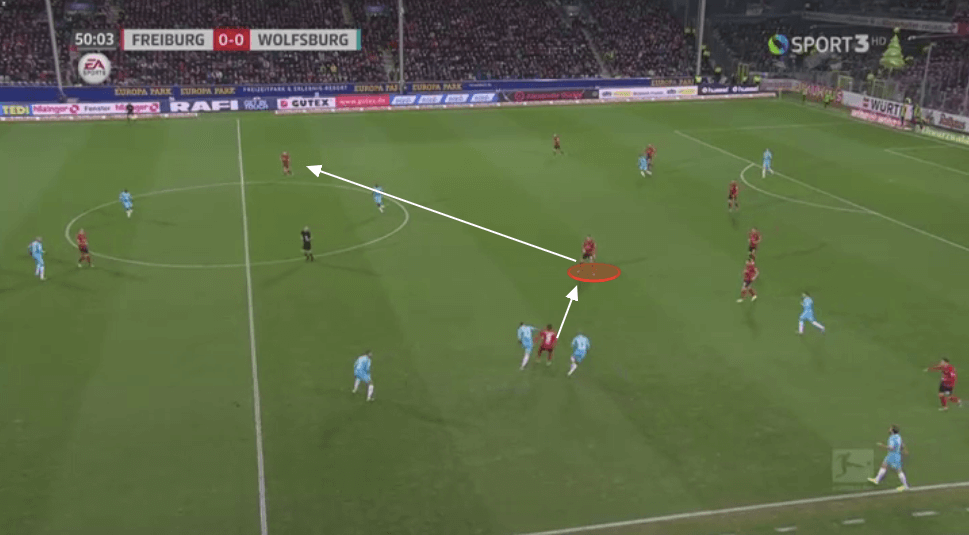
Yet he will also move forward, and leave space for his centre-backs to drive into with the ball. By doing this he can take a higher position closer to his centre-forward, and be goal-side of his marker who is wary of him making his typical run towards the ball to receive from the centre-back. By operating in this higher position he creates a direct passing lane again into the centre-forward, whilst is also an immediate option for the centre-forward to play short to.
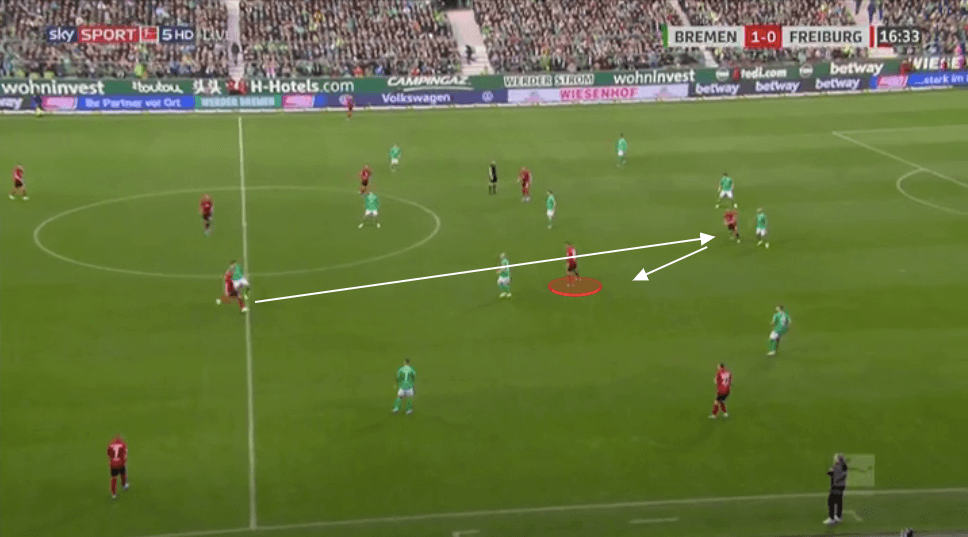
Haberer creates space for himself as well as his teammates. In attacking areas, he is intelligent with his movement. Defenders are aware of him pushing forward, and Haberer will look for balls over the top in the space between the left-back and centre-back. He uses this to his advantage to create space for himself in deeper areas too.
With the centre-back in possession, he will make a forward run taking his marker with him, as we can see below.
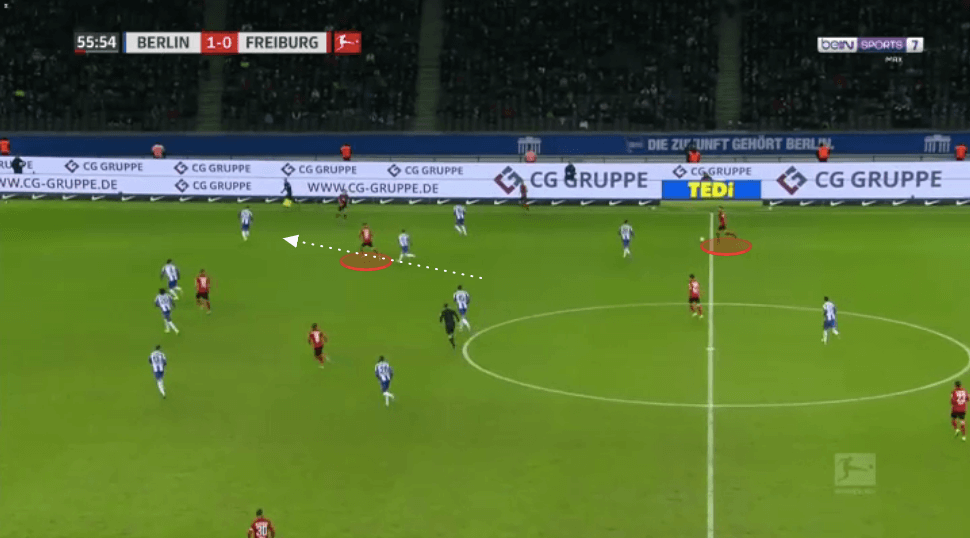
In doing so, he creates space in midfield, and will simply check back quickly to receive from the centre-back.
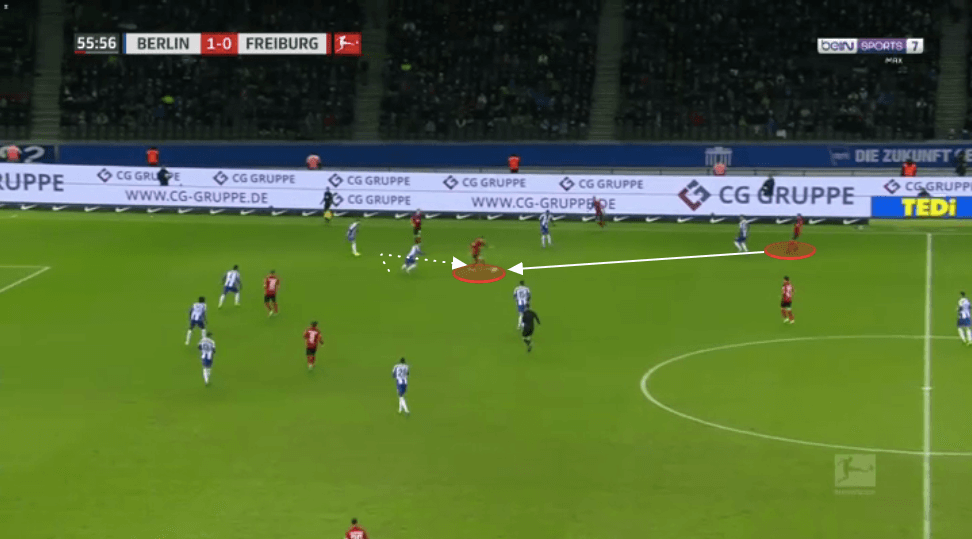
His horizontal movement is just as intelligent as his vertical movements are.
He constantly supports the ball-carrier in build-up play whether that’s to drop deep to give an option or to move laterally and create numerical overloads in wider areas.
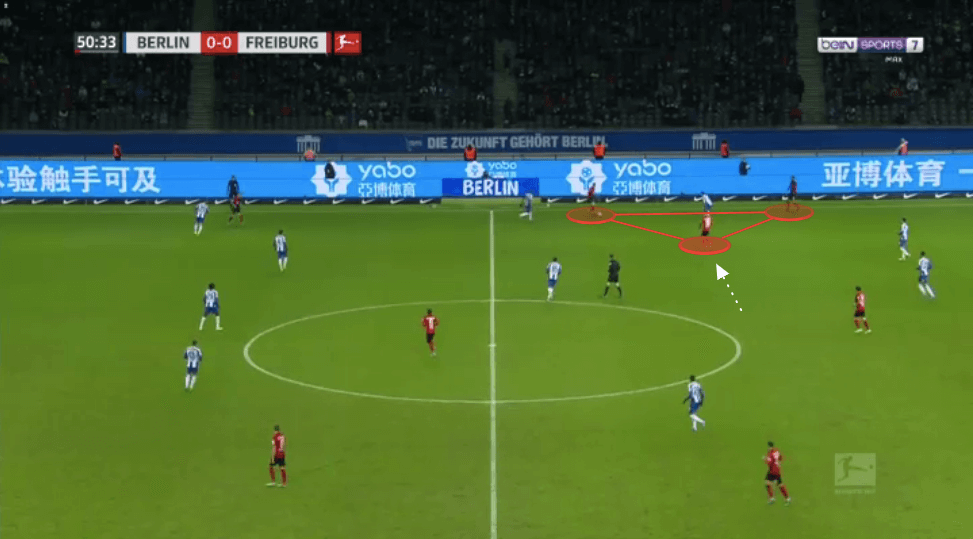
When playing as a right-midfielder, he will often come inside and play as an extra central-midfielder, helping Freiburg crowd the midfield defensively, but in attack, creating an extra option. By moving inside he also creates space for Schmid to move forward and get space.
In the image below we can see how Haberer’s move inside brings his marker inside with him, as Hertha Berlin remain compact. Schmid is on the far side, and is an easy option to switch to, with plenty of space.
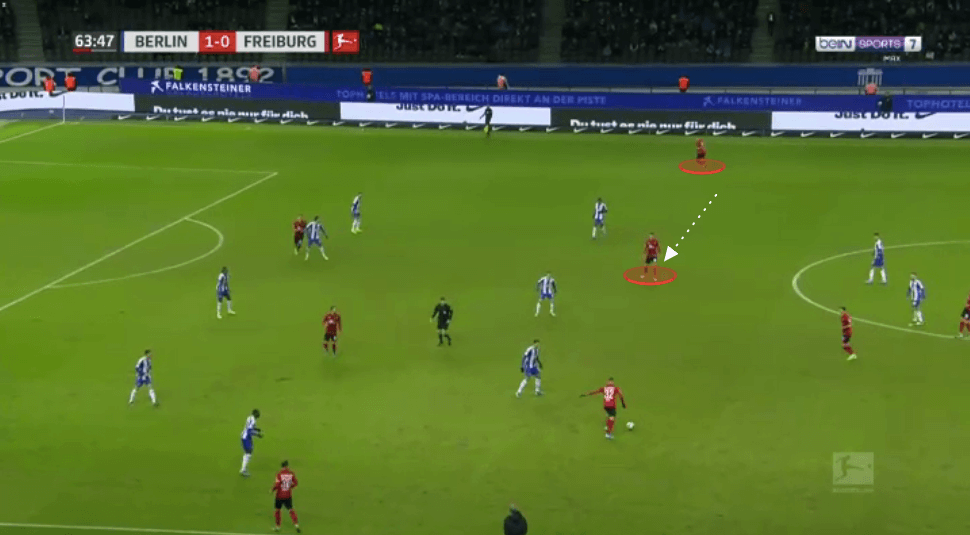
Haberer is skilled at creating openings for Schmid and I will discuss this in more detail later on.
Haberer has a good reading of the game and knows when to move out of the middle too, to create space and be an extra passing option.
The image below shows this as central midfield teammate Nicolas Höfler has possession, Haberer drops out to the right side to create an extra option whilst ensuring there are easier forward passing options in the centre too, to the two strikers.
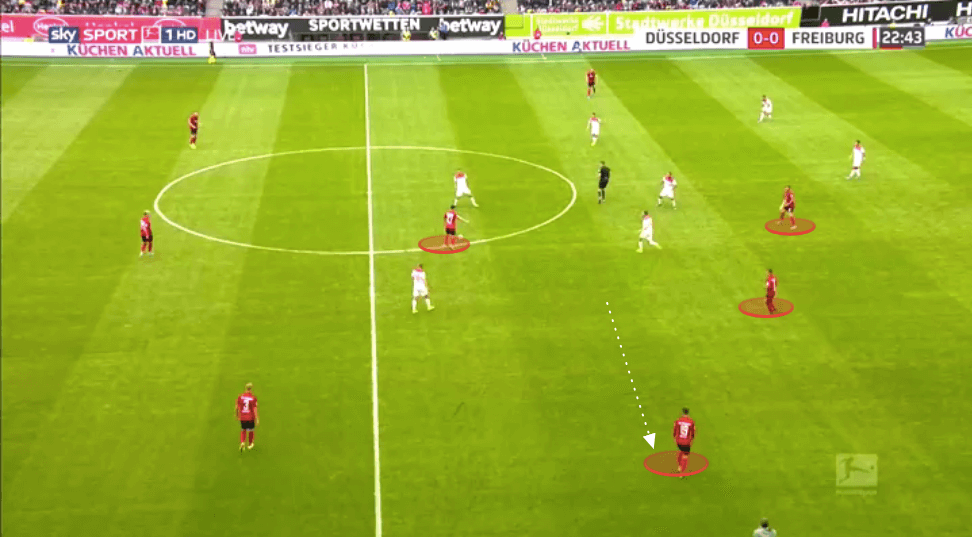
Creating attacking opportunities in wide areas
When playing as a right-midfielder, or as a right inside-forward, he uses his movement brilliantly to help release Schmid.
The reason I use the term right-midfielder rather than winger is that Haberer likes to drift inside, often unmarked and drop into the half-spaces to receive the ball. Streich gives him a free-role from this position at times, and it’s not uncommon to see Haberer create a central-midfield three, or push higher and play as a 10. As much as this is down to Haberer’s ability to find space and create it for others, it is also to allow Schmid to push higher and effectively play as a right-winger himself.
Haberer is so effective at creating space for Schmid on this right-side, luring the opposition left-back or left-winger into playing more centrally than they would ideally like to, as initially standing near them, he will drift inside, seeking to bring them with him, as mentioned earlier.
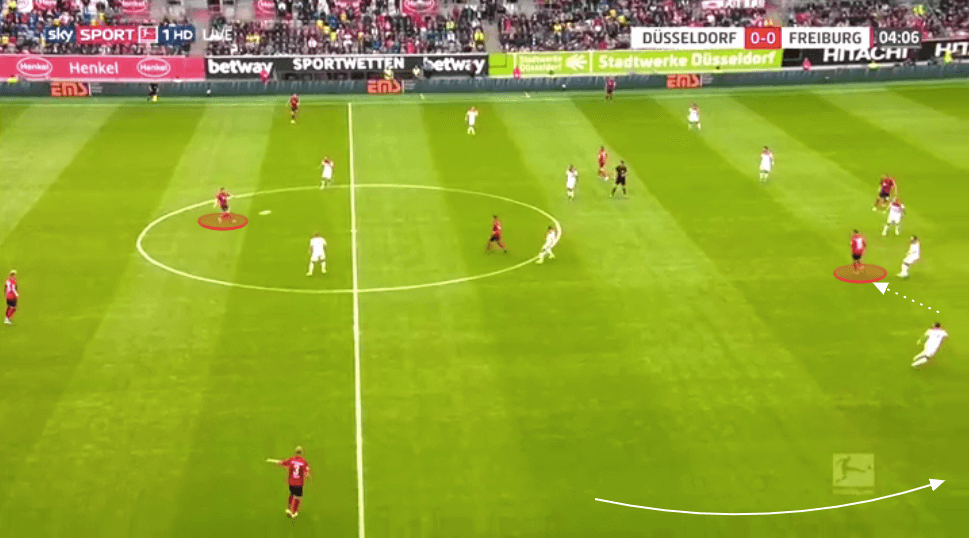
As he does this it allows Schmid the opportunity to make a run in behind into the space vacated by Haberer, where he can be played in.
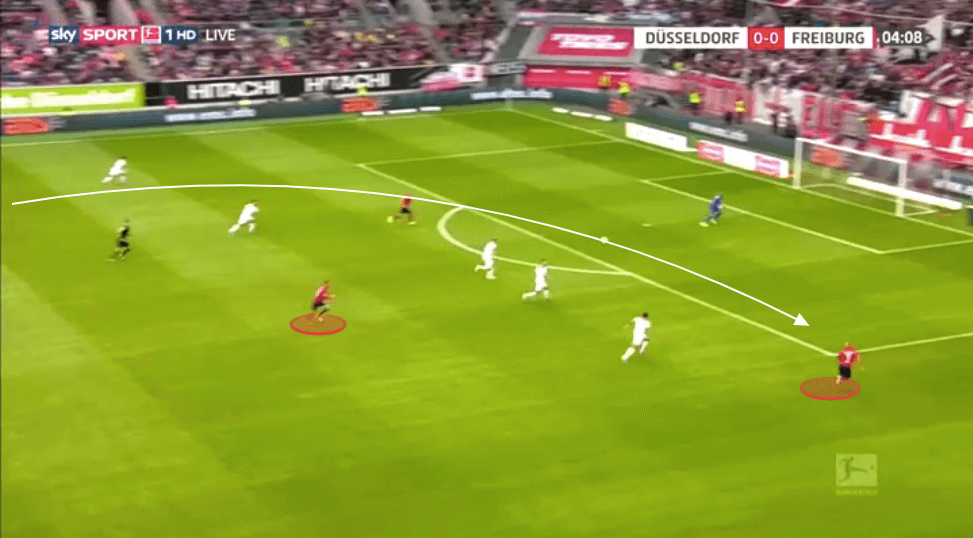
When starting from a higher position, Haberer will also drop deep rather than just moving inside. Again as he does this he looks to lure the opposition left-back forwards and create space for Schmid who hugs the right touchline.
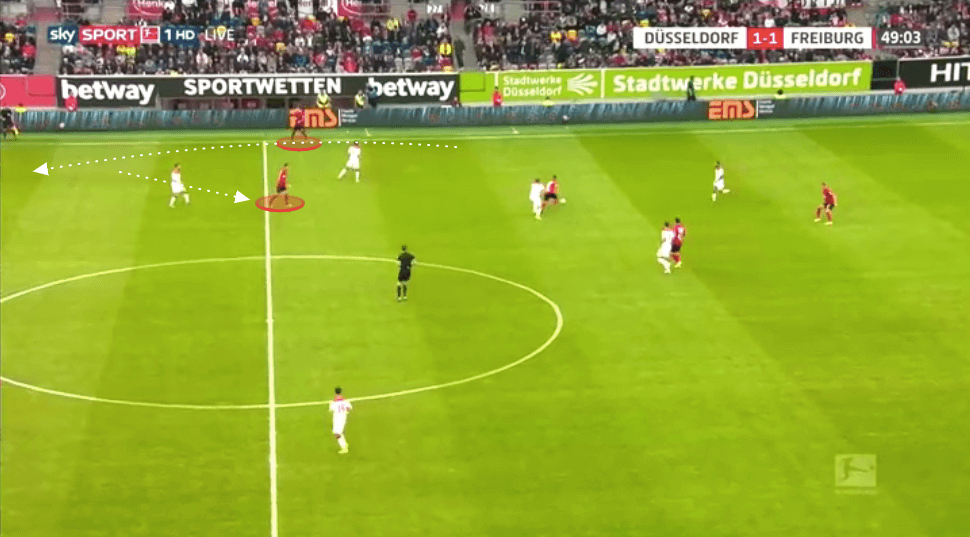
The good understanding Haberer and Schmid have between one another is noticeable, and Haberer will exploit the same space Schmid does too.
By dropping deeper into the half-spaces or into the centre of midfield, Haberer becomes an extra man and is often able to avoid being marked. Should the pass be played to Schmid in a deeper, wide area, Haberer will then seek to push forward himself. As Schmid receives the ball, the opposition left-back pushes higher to press, as he is the only attacker on this flank. Yet as the defender does this, Haberer uses his considerable speed to quickly penetrate the space between the left-back and centre-back.
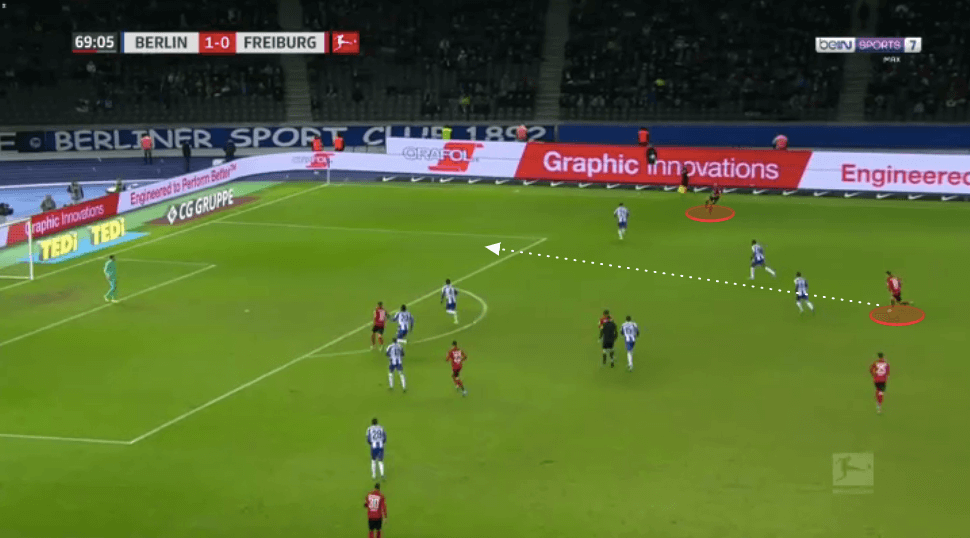
Haberer’s height certainly makes him a threat when Freiburg cross from the left-side. He is usually much taller than the left-back playing against him, and when isolated in an aerial battle, is a goal-scoring threat from crosses. Although he has had opportunities from this area this season, he is yet to score from such a chance.
With Haberer often dropping into deeper areas it means he is able to make late runs into the box, and due to this positioning is once again able to elude marking, and make a free run into the box.
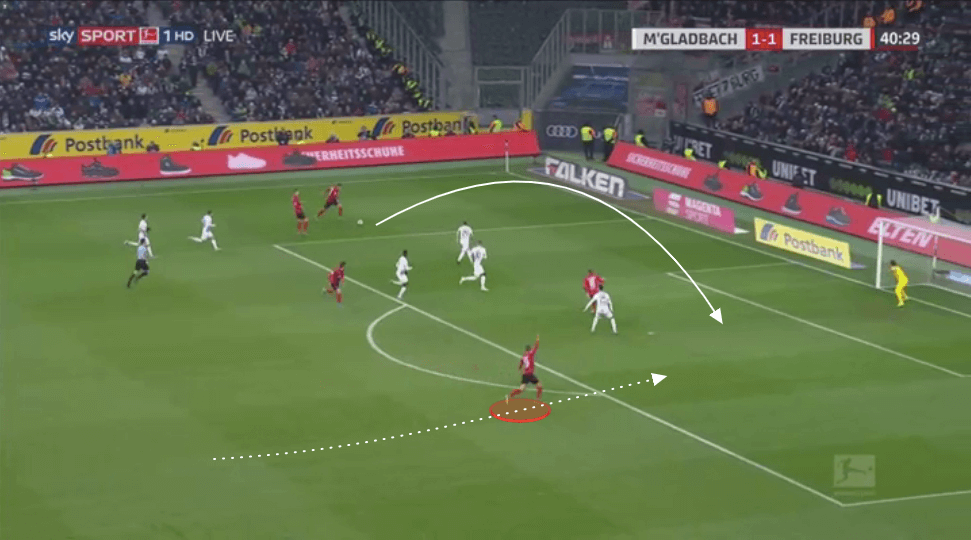
Areas for improvement
Haberer is not the strongest scanner, and has been caught out in several games this season, losing possession due to not scanning enough, and not seeing opponents closing down the space he occupies.
In the image below, for example, he receives the ball without scanning and plays a soft pass back to his defence, completely unaware of the Werder Bremen defender on his shoulder, who quickly reacts and wins possession in a dangerous area.
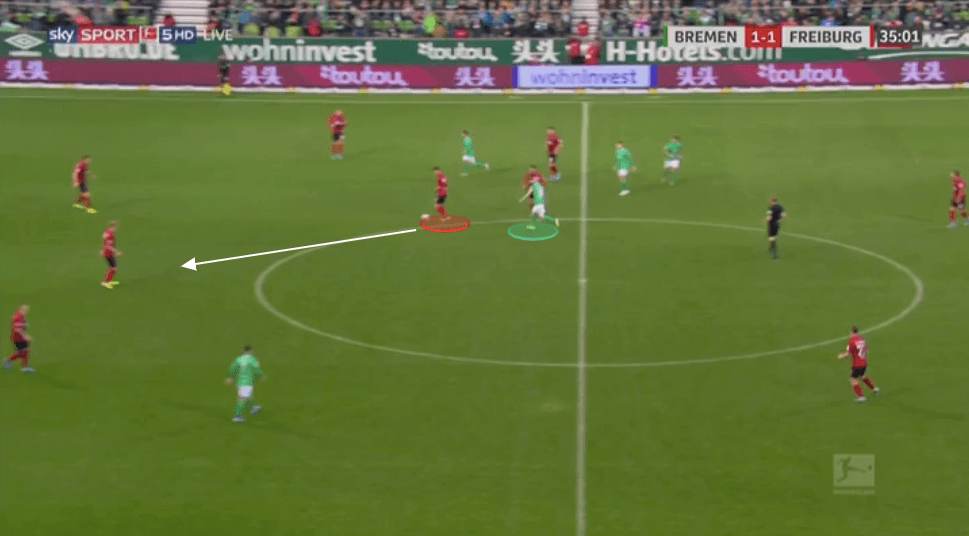
Haberer is better playing off of one touch, but to truly become a midfielder who can dictate tempo in the middle of the pitch, he has to improve his scanning and do it more frequently. By playing one touch there is of course less time to make a decision, and he can’t make playing wayward passes in his own half a habit.
Again the example below shows how Haberer hasn’t scanned to see two opposition players hovering close to the intended destination of his pass. By not scanning he doesn’t put the required weight on the pass, and it is intercepted.
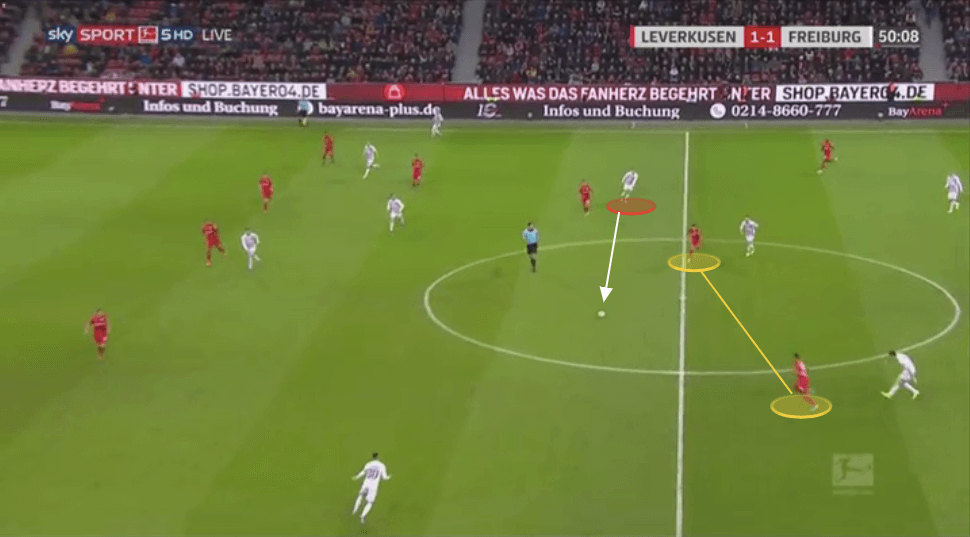
The reason I suggest he is better off of one touch is at times his first touch can be found wanting, letting the ball get a little far away from him at times.
This is not to suggest he has poor ball control, rather he can sometimes hold onto the ball for too long and encourage too much pressure, often due to a heavier first touch.
Haberer also needs to improve his attacking output. Just two assists and one goal is undoubtedly not as potent as he would like, and Haberer has the attributes to contribute more in an attacking sense. A glance at his shot map from this season shows that half of his shots have come from outside of the box, and for him to improve his goalscoring record he needs to take more shots in general, but certainly more shots from inside the area.
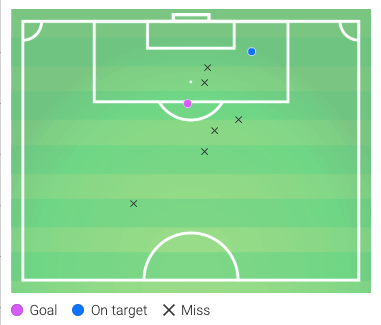
Conclusion
Despite this, his ball control is good on the whole, and he is excellent when playing in tight spaces in the attacking third. He is a confident dribbler with a 59.3% completion percentage this season, who has regularly shown poise and creativity to play through crowded midfields with his dribbling ability, or with delightful quick interchanges with his teammates to bypass defenders.
Playing in a deeper role certainly restricts this, and although he is good at manipulating the opposition shape in build-up play, he can be just as effective doing this with more advanced attacking play, whilst continuing to be an attacking threat.
Haberer’s off the ball movement is of the highest level and he frequently creates space for himself and his teammates to help Freiburg advance the ball forward and into dangerous attacking areas. He has an excellent understanding of manipulating space and is able to draw opponents out of position to the benefit of his team.
I believe Haberer’s best position is operating as an 8 in a midfield three. From this position he is able to drop in and affect Freiburg’s build-up play, whilst also still get forward and penetrate the space between the left-back and centre-back. He can also still link up well with his right-back from this area. His height is a big advantage and he is a real threat when pushing forward to attack crosses, particularly if he can isolate himself against a smaller opposition left-back. However, he does need to improve his production level. Two goals and one assist this season isn’t enough, and may deter some clubs from pulling the trigger and signing him.





Comments